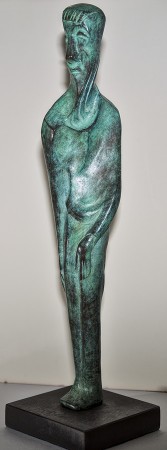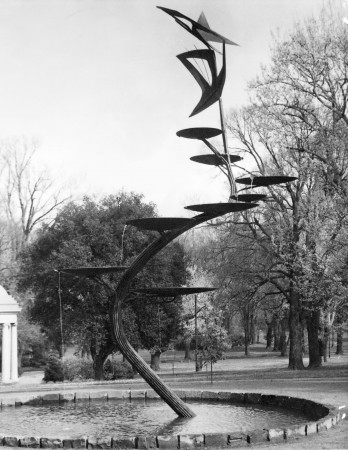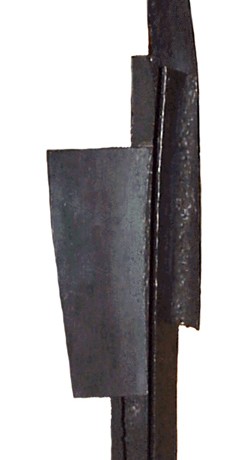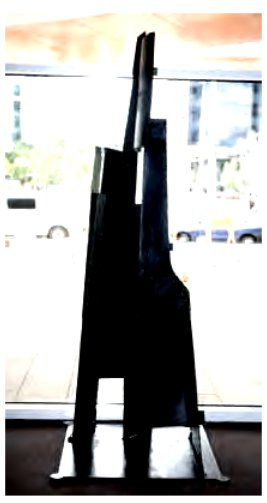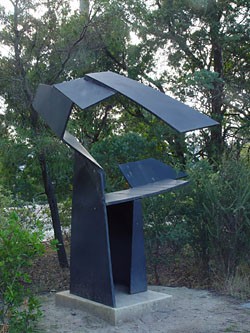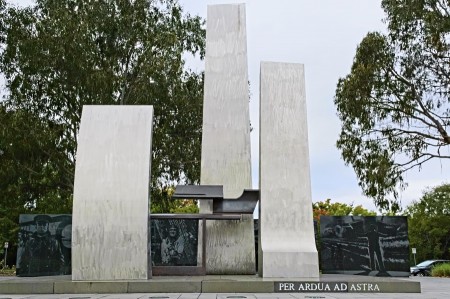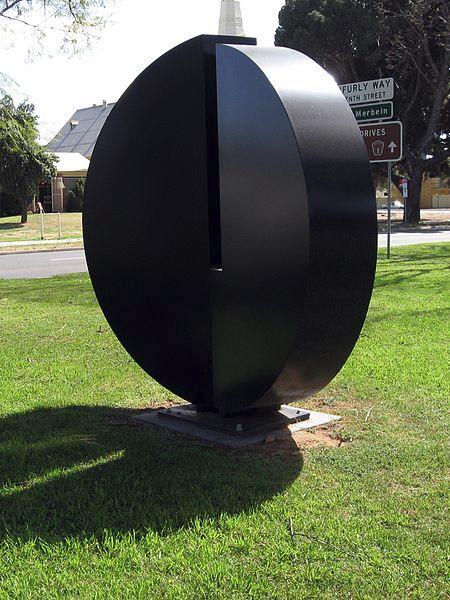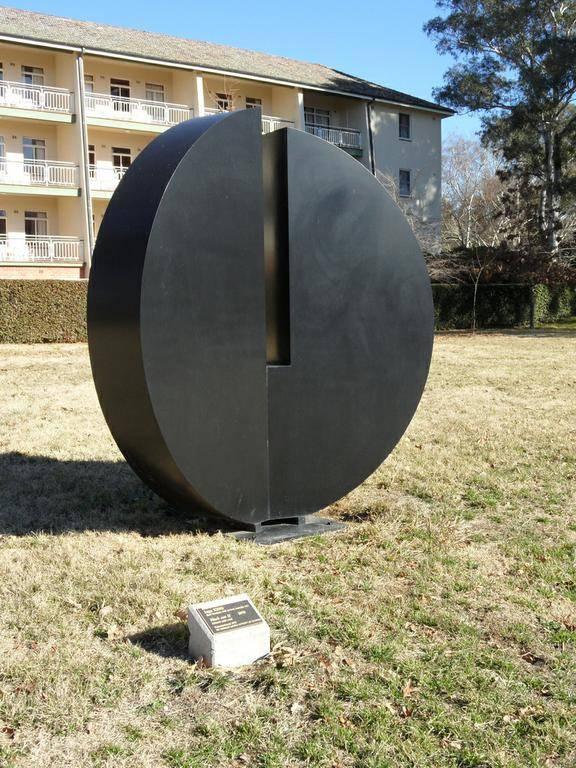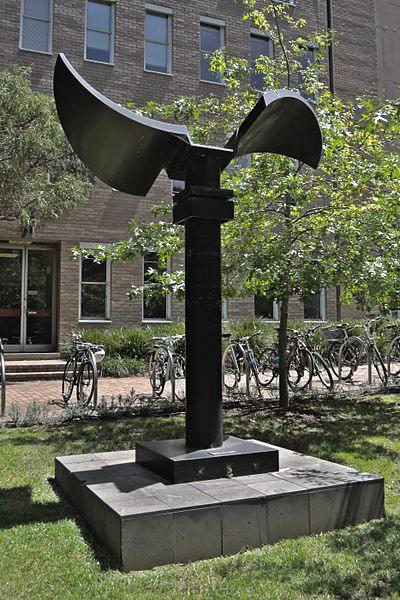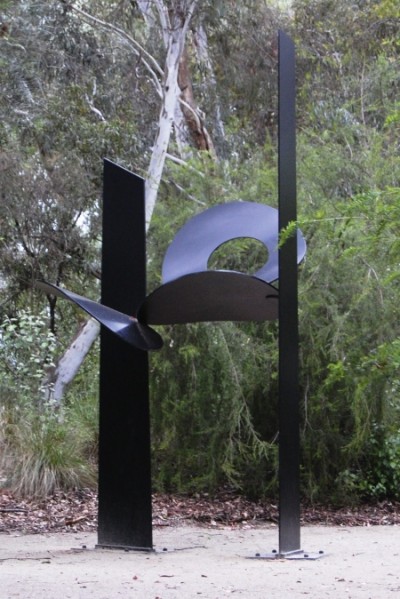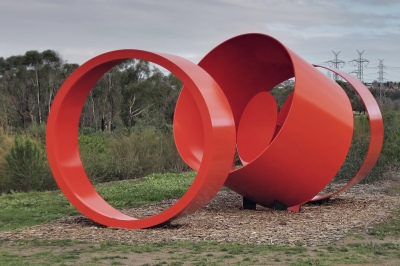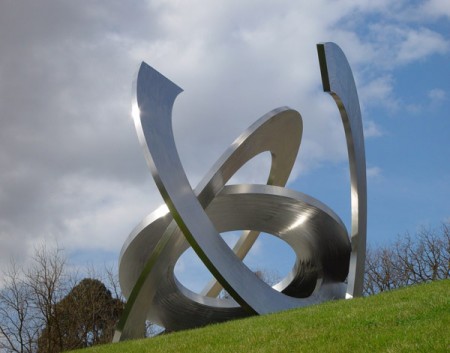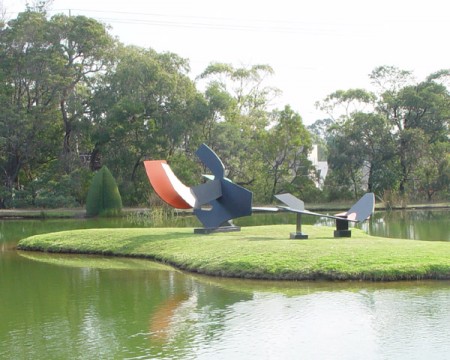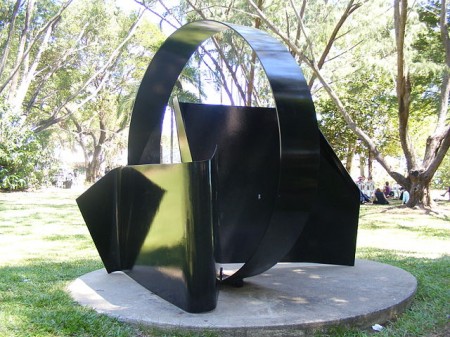The starting point for this list is the book Inge King Sculptor (1996) by Judith Trimble.
References IKS-xx are to page numbers in this book. IK-yy are page numbers in the 2009 book Inge King with essays by Judith Trimble and Ken McGregor. GM links are to Google Maps.
In the left column, we have listed only those works which are, or were, on permanent public display. In the right column we have mentioned some of the works which are in collections of galleries, but which may not be on permanent display. In August 2009, the National Gallery of Australia search page artsearch.nga.gov.au , for “Inge King”, returns 11 sculptures, 8 linocuts, 3 drawings and 1 screenprint.
Where a sculpture’s development is described with a range of years, it is listed below in the most recent of those years.
Sometimes a sculpture was designed on commission, with a smaller sculpture being created as part of the design process. That smaller sculpture is known from the outset as a maquette. In other cases, the artist creates a small sculpture and later, perhaps decades later, used this design for a larger public version of this design. Then, the original is known as a maquette.
Below, the sculptures are listed according to the year in which their larger version was installed in a public site. The titles of those which are no longer publicly accessible are in grey. Only those still in existence are listed in the Location Guide pages.
“commons” is a link to the subcategory for this sculpture at Commons.Wikimedia.org.
List
| Photo | Description, location and other information |
Saint: Statue of St Joseph |
2.44m tall reinforced concrete in a niche, 6 metres above the ground. St Joseph’s School, Chelsea (a Melbourne suburb). This was destroyed before installation was complete.”The 2.44-metre-high, abstracted figure with angular and rounded planes was modeled in clay and then cast in reinforced concrete with the help of Grahame King and sculptor Teisutis (Joe) Zikaras. The figure was conservative from King’s point of view, and well liked by the priest who briefed her, but he died before its completion and was replaced by an old Irish priest who disliked both the building and the sculpture. Soon after the figure was erected in 1955, and before the scaffolding was removed,St Joseph was found lying on the ground, broken off at the ankles and smashed into six pieces. It lay forlornly in the school yard for some years before disappearing completely.” (IredKS-25, which goes on to describe the attempted destruction of the 1957 work The Thing by George Allen.) [#Saint]
The photo is a maquette of the sculpture. Maquettes: IK-13. |
Dewdrop Fountain 1968 |
Dewdrop Fountain was located in the Fitzroy Gardens, directly east of the central business district of Melbourne. It was removed in 1991 (IKS-197). The clear, detailed, frontispiece photo in IKS is by Mark Strizic depicts the top of the fountain obscuring the Sun, with waterdrops and children splashing all about. That photo is about halfway down this page for a Mark Strizic exhibition. The fountain was commissioned by Robin Boyd. The National Archives photo is from 1968.Here is an extended quote from IKS-32 describing the design and construction of this work.I think Dewdrop Fountain was a really beautiful work. Perhaps one day it will be recreated – though fountains are out of fashion these days due to the shortage of water. |
Bush Family 1961 |
|
Gothic Figure 1961 |
Inge King, Gothic Figure, 1961, painted steel, 200 x 56 x 35 cmThis is listed as part of the collection in a partial listing from 2005 (link). Gothic Figure was purchased by the University of Western Australia in 1962 (IKS-50).This 2002-05-02 newsletter (link) has a picture of Gothic Figure, which was located in a “secluded little courtyard on the north-west corner of the Arts building”.In August 2009 Gothic Figure was on display at the Lawrence Wilson Art Gallery lwgallery.uwa.edu.au – until 13 September. The sculpture was removed from the courtyard due to the impact of the elements. A great deal of conservation work was carried out and the work was part of the 2005 exhibition Australian art in the UWA Art Collection lwgallery.uwa.edu.au/?p=72788 .I hope to make a separate page for this sculpture, with photos and an account of the sculpture being thrown into Matilda Bay of the Swan River by drunkards in the early 1960s.Judith Trimble (IKS-39) describes Gothic Figure:
“Gothic Figure is a tall assemblage of flat, welded shapes, cut from scrap steel and articulated with molten metal hardened into a rich texture. King was pleased to use found materials; they were cheap and their various shapes offered endless ideas for composition.”
[#Gothic_Figure] |
Dancer
|
IKS lists three 1962 sculptures which are in the collections of public galleries. As far as I know, only Great Gate is on permanent public display. Here are some notes about the other two. Please let me know any further information of interest:
Dancer steel painted black, height 91.5 cm, collection Newcastle Region Art Gallery. On 2009-08-13 I spoke to Penelope Finnigan at the Newcastle Region Art Gallery www.nag.org.au . They have Dancer and Enigma (39 x 77 x 28 cm, listed as 1983 in IKS, with a photo on page 125). Both works are in storage and only occasionally shown, due to their large collection and very limited exhibition space. Penelope described them:
Dancer is dated 1963, is constructed of painted and welded mild steel plate. It was first exhibited at the Centre 5 exhibition at this Gallery in Sept 1963, and was purchased from the exhibition. It is unsigned and measures 110 x 37.3 cm.Enigma, 1984, was purchased in 1985 with a grant from VAB board of Australia Council. It was exhibited at Realities Gallery (Melbourne) April/May 1985. The Gallery has sent me a GIF storeroom photo of Dancer. This is the only photo I know of this work. To the left is a retouched version of that image, lightened and with the background inexpertly removed. A higher resolution version is here.
Flying Form painted steel 57 x 106 x 41 cm. (Photo: IKS-41.) National Gallery of Australia, Canberra. In August 2009, this is listed in the NGA system IRN=82562 but there is no photograph. The only mention we could find of it with Google is an appreciative comment, from 2000, by Alan Sisley. The work was in a touring exhibition The Europeans and Alan Sisley wrote:
“Inge King’s work Flying Form of 1961, is one of my favourite pieces in the show, welded steel of surprising airy grace. I wonder if it is just the context of this exhibition that causes me to see the ranked horizontals in grey steel as serried bombers? It is a highly original composition that is pleasant in form and texture.”
|
Great Gate 1962
|
(Kinloch Lodge foyer)IKS-197 states that Great Gate (244 cm tall) was part of the ANU collection. Great Gate is sculpture 15 in the ANU brochure “Sculpture on Acton Campus” (July 2005) facilities.anu.edu.au/files/1226_sculpture_brochure.pdf Page 14 has a photo. The brochure’s map’s orientation is not north-south. My Google Maps coordinates are based on this map, and I think I can see the sculpture in the satellite photo. ANU has many fine-looking sculptures on permanent public outdoors display, such as Gregory Johns’ Guardian Figures (2003). I look forward to walking the ANU Sculpture Walk.This work is a maquette for a project that was intended to be larger. Many of King’s works represenheight=”460″ /> IKS-59 Christies’ photo |
| IKS-198 lists one work which is in a gallery collection, but I think it is not on permanent display: Winged Image, first version, steel and copper, height approx 91.5 cm. Collection National Gallery of Victoria. This is listed in the NGV catalogue, but there is no photo: www.ngv.vic.gov.au/collection/pub/itemDetail?artworkID=26248 . |
|
Flight Arrested |
Flight Arrested is a welded steel sculpture, 242 x 255 x 218 cm. This is the earliest of three Inge King works at the McClelland Gallery Sculpture Park: https://mcclelland.org.au/ . |
Euridice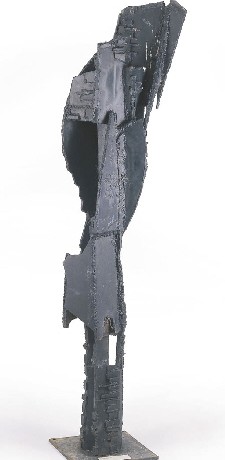 IKS-59 Christies’ photo |
Euridice is a welded steel sculpture 202 x 55 x 35 cm which was installed in a pool in front of the BHP Research Laboratory at 245-273 Wellington Road, Mulgrave (a south-eastern suburb of Melbourne). My research indicates a new building was built at that site in 2005, not for BHP. BHP was a large mining and steel-making company and is now part of BHP Billiton.From Judith Trimble’s IKS-53: “By the time the Centre 5 sculptors were invited to exhibit at the Art Gallery of New South Wales, King’s work was taking on the teutonic quality already established in Tenement. She showed Euridice, Observer, Dark Tower, Tenement, Sculpture 65, and Captive.”Euridice was sold at auction by Christies on 6 May 2003. The The Christies page for this work: www.christies.com/LotFinder/lot_details.aspx? intObjectID=4090614 includes quite a good photo and some interesting information, including much of the following. Euridice was exhibited in Tokyo in 1967. BHP acquired it from the artist in 1967 for BHP House, a prominent Melbourne CBD building which was completed in 1972: en.wikipedia.org/wiki/140_William_Street (also emporis.com) . This is a muscular-looking reinforced concrete skyscraper which was Melbourne’s tallest building between 1972 and 1977. The work was acquired along with some others, including Inge King’s Balance of Steel Forms (1971-72) from BHP by the owner who auctioned them in 2003. I am not sure whether Euridice was at BHP house, since IKS-59 indicates it was purchased for the Clayton (AKA Mulgrave) Laboratory.Euridice may seem at first like a bunch of scrap metal melted together – there’s a lot of this sort of thing in steel sculpture. However, as quoted in the Christies page, Judith Trimble’s description (IKS-59) indicates a great deal more thought went into it’s creation: “…Euridice was produced in maquettes of steel and copper, and in bronzed steel during 1964 before the final, full scale, black painted steel sculpture was realised in 1965… Euridice presents different compositions from all sides, appearing as a dense compaction of thick, flat, irregular steelplates, and, from some viewpoints, sometimes as enfolding curved plates around a tall, spatial core… (its) density in some views suggests an organic character formed by molten metal, rather than assemblage. By 1965 such expressive monumentality has become the dominant aspect of King’s Abstract Expressionism.”
I wonder where Euridice is today. |
Observer |
Observer is a 147 x 70 x 50 work in “bronzed steel”. IKS-199 lists it as belonging to the collection of the National Capital Planning Authority in Canberra www.natcap.gov.au . In the past it was installed in a public courtyard near some shops, but after being damaged by vandals in 1977 (according to my conversation with Inge King 2009-08-20) it is now indoors, in the reception area of the National Capital Authority’s reception area, in the Treasury Building, at the western end of King Edward Terrace, Parkes ACT. I understand this is open to the public 8:30AM to 5PM weekdays.On page 11 of the James Gleeson’s 1979 interview Inge King discusses the construction of Observer and states that it was purchased by the “Art Advisory Board about 1967” and how it was installed in a small square near Northbourne Ave. The agreed it was an important work and she said “I still consider it a piece I like”.An article in The Age, (Google News archive 1966-10-05) takes a generally dim view of the Victorian Sculptor’s Society annual exhibition, but concludes, with a reference to Vincas Jomantas’s Myth:
“In the other gallery Inge King’s Observer stands grimly aloof both in situation and quality from its co-inhabitants. Like the Jomantas piece, it is the presence of this work which is so impressive. The form itself watches, guards and hovers over the spectator. We don’t translate its meaning: it’s simply there, inescapable and rather daunting.”
According to the 1979 interview, in the past, Observer has had a rough time outdoors and traveling around to schools. Now it is safely indoors. I look forward to seeing it. It is a sculpture which made a big impression on Judith Trimble, despite it not being particularly tall. IKS-54: One of the four “most brutally expressive” of her works, the others being Euridice (1965), Monitor (1967-68) and Double Boulder (1967-69).IKS-57: A lot of interesting discussion, including its “daunting, authoritative effect” and: “In this work King exploits the lifeless inky blackness of shadows against lively surfaces delineated in brilliant sunshine. Brutality of form and a calculatedly crude handling of material and technique are critical to Observer’smonumental impact”.
Following my conversation with Inge King on 2009-08-20, here is my understanding of the background to Observer. In 1964 she first created Male and Female 78 x 22 x 33 cm which is pictured on IKS 54. From a rectangular base-plate, two columns rise, both made of multiple elongated rectangular steel plates welded pretty roughly together. The caller column has a narrow roughly cylindrical head on a vertical axis and the shorter one has a wider, shorter, roughly cylindrical head on a horizontal axis.This was intended as a maquette for a full-scale rendition 6 to 7 metres tall. This has never been realised – sculptors typically don’t have the money to build large works unless working on a well-funded commission. Inge King decided to enlarge the smaller figure to a size intermediate between the maquette and her intended full-scale height. The result is Observer which is shown in Mark Strizic’s photo on IKS 55 towering into the sky, with the tops of a eucalypt tree behind and below, from a stone base which itself is above the camera’s vantage point. The maquette was in the possession of New Zealand based architects Gart and Renarte Block who were keen to see the work realised on a larger scale. She told me the location of Observer in a small courtyard near shops in Canberra (I am not sure exactly where it was) was a very good setting indeed. I got the impression that the sculpture was mounted on a block of stone, in a quiet corner. It was repaired after being seriously damaged in 1977 and she told me it was “never quite the same”. Here are some further thoughts of my own: Inge King referred to enlarging the smaller figure. Here, I think “figure” means the design of the physical object – not the actual object of the smaller column in Male and Female.There’s a lot of welded steel sculpture in the world now, and I have the impression that quite a lot of this which involves rougher welding and multiple plates and other pieces which don’t fit precisely together, is the result of a relatively unplanned session with a pile of scrap metal and an arc or oxy welder. This sounds like fun! It is my impression of most or all of Inge King’s work, including her welded steel assemblages such as these two sculptures, results from a great deal of planning and deliberation. In this sense, the most important thing about Observer is that it is a larger and presumably truer physical rendering of a single figure which was first rendered as one of a pair in the smaller Male and Female. Yet this figure – this conception or design was from the outset intended by the artist to be realised as part of the pair of figures where the taller one reaches 6 to 7 metres – four times taller than most adults. Observer made quite an impression when it was first shown. It is apparently meant to be mounted on a block of stone, above ground-level. Now it is safe from vandals and the elements, but it is indoors – and I understand it is mounted at ground level. In the future I hope to be able to reproduce here some photos from the Inge King Sculptor book. When viewingObserver today, it may be helpful to consider its context – as the intermediate embodiment of one part of a work which from the outset Inge King wished to construct on a scale which would have the “heads” of both figures towering above our heads and our outstretched fingertips. |
Organic Form 2009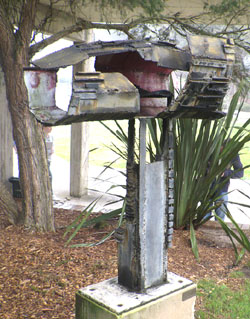 Photo copyright University of Ballarat, used with their kind permission: |
This page for more photos and information. The University of Ballarat collections entry is
www.ballarat.edu.au/curator/collection/
view_notes.php?id=327 Catalogue No.UB055; Title: Organic Form; Date: c1967; Artist Name: King, Inge; Media: Sculpture – welded metal Size: 134.0 x 116.0 x 46.0 Purchased by Ballarat Teachers’ College students and staff of 1966 – 1967. In August 2009 I corresponded with the Curator of the Art and Historical Collection. She wrote: “The name we have for it is Organic Form. This name is reported in a 1967 newspaper article at the time of purchase.” She measured Organic Form as 134 x 116 x 46 cm. On 20 August 2009 I spoke to Inge King by phone and we discussed this work and the two entries on IKS-199, both for 1965: and I told her that University of Ballarat have a work with the same height Organic Form – and she said these two entries were clearly for this work – though this was not a name she remembered for it. I have only seen photos of this work and she had not seen these photos yet (she does not use the Internet). She had seen the work in recent years and mentioned how it was possible to look through it and how it could probably do with a new coat of paint. Tina and I enjoyed viewing Organic Form in April 2011. The Art Gallery of Ballarat (site) also has a smaller sculpture Awakening from 1987-87. A photo from the Gallery site is here . There’s another sculpture with the same name Awakening in Burwood Park (Google Maps) about 8km west of the Sydney CBD. It is illustrated on page 15 of the brochure for the television documentary. |
 |
We haven’t yet listed two other works in Ballarat. There’s a four-tonne, five metre high, piece Grand Arch in Camp St (Articlefrom November 2001.) There’s an image here and from Google Street View: |
| This is listed in IKS-199 as:
1967-68 Boulder
bronzed steel, 99 x 76 x 66, collection of Warrandyte Community Centre. I will call them. |
|
Balance of Steel Forms |
IKS-200 describes this as 1971-72, black painted steel, 213 cm high and “collection of BHP Melbourne”. I assume it was on public display.According to IKS-71, Balance of Steel Forms was commissioned for the BHP Head Office in Melbourne. Please see the notes on Euridice above. The Christies auction notice (it was sold on 2003-05-06) notes: “Commissioned by Kim Bonython for The BHP House Collection, Melbourne”.These heavy boxes seem to have been caught in the act of tumbling upwards! IKS-62 has a photo of Great Boulder (1968) which also involves rectangular steel shapes in a conventionally improbable configuration.I wonder where Balance of Steel Forms is today. |
Schonell-Fountain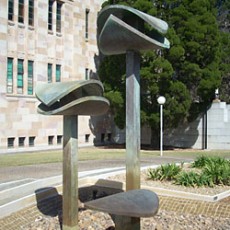 IKS-77 2009 photo copyright John East, used with his kind permission: |
Schonell-Fountain Please see this page for more information, historical photos from 1972, 1990 and 1999 kindly provided by the UQ Library and some contemporary photos taken in August 2009. Due to water shortages, the fountain and all other water features at the St Lucia campus are dry.According to this report (link) The Schonell Memorial Fountain is mentioned in the book: Monumental Queensland: Signposts on a Cultural Landscape (2004). However, it is my impression that few people at UQ today know it by name. It does not appear in the campus map, but in late 2009 a nameplate was affixed to the stone border around the base of the sculpture – so it should be more widely known now asn in the future.Sir Fred Schonell en.wikipedia.org/wiki/Fred_Schonell (1900 – 1969, pr. emphasis on “ell”) was Vice Chancellor of the University of Queensland from 1960 until 1969. |
Airforce-Memorial |
This memorial commemorates the 50th anniversary of the Royal Australian Air Force. It is located in a long treed avenue – Anzac Parade. ANZAC stands for the Australian And New Zealand Army Corps and more generally refers to Australian and New Zealand military co-operation. Extensive documentation of the memorial is available at: www.skp.com.au/memorials2/pages/00009.htm .Here are some quotes from pages 8 and 9 of James Gleeson’s excellent 1979 interview:
“Anzac Parade is a formidable area because it’s like a big military avenue, if you like. They have those niches where they eventually want to put more sculptures. I knew there were steps leading up to this area and we got the size of the area. We knew what kind of trees they were going to plant. This was one of the first works where I used a number of units. Partly again I thought that people might move in between the units.But most people will drive along Anzac Parade; very few people will walk. When you drive along this horizontal unit slowly moves. You start to see a bit of it and then it moves behind another vertical unit.JG: In relation to the wing shapes.IK: Yes. Therefore you get a form of movement when you go past of the whole thing, because otherwise it’s a rather static design. This was the way I figured this work out. Actually, it consists of, I mean, the stainless steel are quarter inch and three-sixteenth plate. This was fabricated. I did all the finishing. I did all the grinding on that thing, because I wanted a certain way of grinding. It was interesting that when it went up in Canberra, I was really taken aback. Because I didn’t realise until then that the light in Canberra was entirely different from Melbourne. It’s a very stark light.”
|
Black Sun 1974-75 |
Black Sun 1974-75 steel pained black, edition 2239 x 208 x 72.In the collection of the Mildura Arts Arts Centre.BlackSun is the first of a series of sculptures, based in a black disk mounted on its edge.
The name plaque for this sculpture is missing, we hope the Mildura Arts Centre will rectify this omission. |
Black Sun |
Black Sun II 75 steel pained black, edition 2239 x 208 x 72.In the collection of the Australian National University. |
Upward Surge 1974-75 |
Upward Surge 1974-75 Australia Painted steel 169.0 x 142.0 x 122.0 cm.Situated at the eastern end of the John Medley Building “Upward surge was commissioned for the Institute of Early Childhood Development, Kew, at a time when great developments in the teaching of children were being made. ‘The sculpture of flight with wings soaring upwards expresses these aspirations’, said King. Upward surge was installed in its current location in 2001. [[1]] |
Red and Blue, 2008 |
Red and Blue, 2008Polychrome Steel (2005)”This sculpture uses an abstract language of colour, form, volume and plane to create a sense of tension and quiet strength. The artist has made a significant contribution to the development of Australian modern sculpture and has been exhibiting for close to 60 years.” |
Wodonga Fountain 1972 |
Wodonga Fountain 1972 Steel and colour. Hight approx 152.5 cm Collection Civic Centre Forecourt Library and Senior Citizens Centre Wodonga Victoria. |
Temple Gate 1976-1977 |
Temple Gate 1976-1977 Purchased 1977, Painted Steel and Aluminum, in the Sculpture Garden of the Australian National Gallery, Canberra. |
Red Rings |
Sculpture ‘Red Rings’ Commissioned by East Connect. The sculpture ‘Red Rings’ by Inge King is located at the junction of the EastLink Trail and the Dandenong Creek Trail. The three painted steel rings are each 2.5 metres in diameter. “I visualise Red Rings as part of the environment; they should challenge passers-by to walk through and arouse their curiosity to explore the forms. The sculpture consists of three circular elements with the centre ring tilted upward to create movement. The rings are arranged one behind the other with varied spaces in between. The red colour is an important part of the concept, contrasting the surroundings and creating a focal point. It is not the size of the sculpture, but simplicity of form expressing strength and tension that is the motivating force.”
|
Rings of Saturn 2005-06
|
Rings of Saturn 2005-06,as displayed in the gardens at the Heide Museum of Modern Art in Bulleen, Melbourne, Australia, viewed from Heide I |
Island Sculpture
|
Inge King’s 1991 steel sculpture “Island Sculpture” is located at the McClelland Gallery and Sculpture Park, 390 McClelland Drive Langwarrin, Victoria, Australia. https://mcclelland.org.au/ This view is looking east-north-east. |
Lunar Image 1980
|
Sculpture Lunar Image (1980) by Inge King in Melbourne/Australia This is out the front of the Museum and Art Gallery of NT |
Sentinel
|
Painted steel, 13 metres tall, Sentinel is located at the junction of the Eastern Freeway and Doncaster Road in Melbourne’s north-east. |
